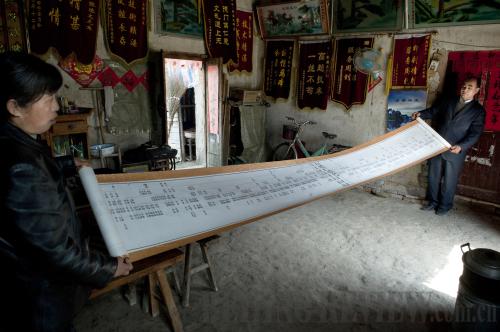|
 |
|
EXQUISITE CRAFTSMANSHIP: Workers show an example of a family tree made by Zhang Dewen, a renowned family tree artist, using traditional printing techniques (GUO CHEN) |
It serves as a family network where people can build their family trees and generate their own content, such as photos and written stories, to continue the genealogy.
"We not only want to satisfy people's curiosity about the lives of their ancestors, we also encourage them to preserve and share their stories with their families and relatives via the Internet. And the records people are keeping now will become a source of inspiration for their descendants for years to come," Shi said.
A delicate art
At the library of the National Palace Museum, two sets of family trees made with traditional handicrafts always attract people's attention. The family trees were made by Zhang Dewen, a farmer from Shitang of Feidong County in east China's Anhui Province.
Zhang uses a technique inherited from his ancestors who lived during the late Qing Dynasty. With his traditional skillset, he can bind family trees into delicate artworks.
Zhang's workshop is in Shitang. Recently, his workshop made a set of 800 books for a local family surnamed Zhou. The job was undertaken by Zhang's family, including his 80-year-old father, who did everything by hand.
"It took us several months to complete the job," Zhang said, adding the whole process was done manually. Zhang supervised almost every step of the process from typesetting and proofreading to plate making, printing and binding.
"Traditional handicrafts are favored by people because they have their uniqueness," Zhang said. For example, the paper used to make family trees has to be xuan paper, which was used for brush painting and calligraphy in China. "Xuan paper is very soft. It cannot be put through a machine, so manual printing is the only option," he said.
Furthermore, ink used for the traditional method is water-based. This kind of ink, unlike the oil-based ink used in modern printing, permeates into the paper. "The ink we use guarantees the printing quality and makes them long-lasting," Zhang said.
Zhang's grandfather and his father's generation had kept the traditional techniques alive.
An opportunity to revive it came in the early 1990s, when a businessman came to Zhang's family to request they help him make his family tree into a book. The first book made by Zhang was for a family surnamed Song. The book was printed with traditional movable type printing. The book was picked up by a collector from Hong Kong later.
With more well-off businessmen and overseas Chinese coming to him to make family tree books, Zhang's name gradually spread across the whole country.
In early 2012, the Pei family in Anhui planned to revise their family tree. They contacted Zhang and in a few months, a new Pei family tree came out from Zhang's workshop.
Due to its precious historical value and exquisite craftsmanship, the book was acquired for the collection of the library of the National Palace Museum and the Capital Library of China later that year.
"Today, many crafts and traditions have been lost to history. I will carry on the traditional technique of my family and make more high-quality family trees for people. I hope the technique can help further promote China's family-tree culture," Zhang said.
Email us at: yinpumin@bjreview.com | 